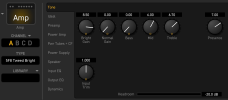When anyone uses "warmth" vs "digital" they almost always mean analog vs digital.
Right...but people mean different things when they say them.
A "digital" sound could (very commonly) mean aliasing, artifacts of data compression, uncontrolled IMD, truncation distortion, missing "pleasing" noise, or...I don't even know what else. Digital doesn't actually have a sound...just a lot of things that people can do wrong if they don't know all the pieces involved. Fractals don't really suffer from any of these, at least not worse than the "real" gear. Some of the amps exhibit things like IMD and crossover distortion...but so do the real amps they're based on. I haven't heard fractals have a problem with aliasing, and I'm under the impression that they're aggressively oversampling where they need to. Everything that distorts can cause intermodulation distortion. All the devices are 24-bit IO, so I'd be surprised if anyone actually heard truncation distortion outside of listening tests (and it might be dithering anyway). And a lot of the blocks cause realistic noise. So...I really don't know where that complaint comes from without more details.
"Warmth", to me, means some kind of shift away from treble and toward low mids or bass. Which is easy.
The one that really gets on my nerves is the idea of "tube warmth". You hear that in terms of amplifiers that are distorting (whether hi-fi amps run too hot or intentionally distorting a guitar amp) because....that distortion
always adds more high end and makes the sound brighter (overtones are necessarily higher pitched than the sounds that cause them). It's just that tube amps are inherently not hi-fi devices and roll off the top octave or so of response on the way out. But...fractals already do this where they're supposed to.
The old trope that analog sounds warmer than digital - so there are the usual ways we do that with digital signal processing to emulate analog gear/recordings.
The terms "warm" and "digital" are so incredibly vague as to be useless. It really seems like everyone uses "warmth" wrong and almost no one can describe what digital even sounds like. Unless some DSP designer is doing something wrong, digital audio doesn't have a sound.
In the end, "warm" just means "good" and "digital" just means "bad"....which means the question is "What I hear is bad, how do I make it sound good?"....which is essentially meaningless without details.
To OP, I really don't mean for that to come off as insulting. I've gotten a lot of help from this forum, and I'd like to think I've helped others at least a bit. But...any of us would need details about how what you're hearing is different from what you want to hear. The answer is probably out there, but it could be almost anything.


